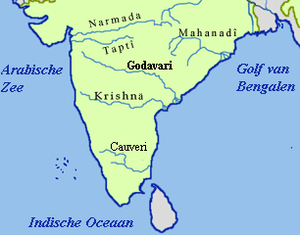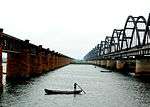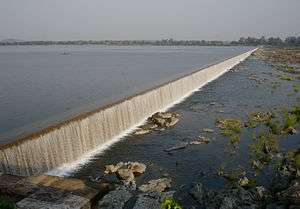Nizam's Guaranteed State Railway
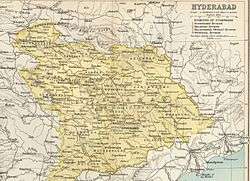 The Hyderabad State | |
| Locale |
Andhra Pradesh, India (consists of former states Hyderabad State and Madras Presidency) |
|---|---|
| Dates of operation | 1870 (1879 fully owned by Nizam)–1950 (nationalized by government of India under Indian Railways) |
| Successor |
Central Railway(1951) South Central Railway(1966) |
| Track gauge | Mixed |
| Length | 351 miles (1905) 688 miles (1943) |
| Headquarters |
Secunderabad Station (1870-1916) Kachiguda Station(1916-1950) |
Nizam's Guaranteed State Railway (NGSR) was a Railway Company in India between 1879 and 1950, and was owned by the Nizam's Hyderabad State. The full style of the system was His Exalted Highness, The Nizam's Guaranteed State Railway which had its beginnings in a line built privately by the Nizam, much to the dismay of the British authorities. It was owned and worked by a company under a guarantee from the Hyderabad State capital for which was raised by the issue of redeemable mortgage debentures.
History

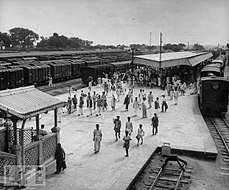
Being one of the largest princely states of India, the Nizam of the Hyderabad State wanted to build a railway line to connect the Hyderabad with the rest of the British India (now India). This Railway line was to be built from Secunderabad Railway Station, Hyderabad, India. The Nizam bore all the expenses for the construction of the line.
The proposed line was to be built between Secunderabad Railway Station-Wadi initially. The earliest sections of the NGSR were commenced during the 1870s, variously financed, constructed and operated. The construction commenced in 1870. After four years of construction works, in 1874, the Secunderabad-Wadi Line was built with financing. In 1879, the Nizam took over this railway line and was managed by the state owned Nizam's Guaranteed State Railway under the Nizam. In 1883, a management company was formed to gradually take over these lines, under the provision of a guarantee from the Government of HEH the Nizam of Hyderabad State. Later from 1874 to 1889, this line was extended to Kazipet and Vijayawada as Vijayawada-Kazipet-Secunderabad-Wadi line.
John Wallace Pringle was appointed as the superintending engineer for the survey and construction of the Hyderabad–Godavari Valley Railway in 1896.[1] The metre gauge railway runs for 391 miles (629 km) from Hyderabad city to Manmad on the north-eastern section of the Great Indian Peninsula Railway and was opened in October 1900.
In 1899, the broad gauge connection between Bezwada (Vijayawada) and Madras (Chennai Central) opened making rail travel between Hyderabad and Chennai possible. The State thus contained 467 miles on the broad gauge, all built before 1891, and 391 miles on the metre gauge, opened between 1899 and 1901. In 1916, another railway terminus, Kachiguda Railway Station was built to serve as the railway's headquarters. In 1950, the NGSR was nationalised and in 1951 became part of Central Railway, a zone of Indian Railways.
The total capital expenditure on the Nizam's State Railway to the end of 1904 was 4.3 crores, and in that year the net earnings were nearly 28 lakhs, or about 61⁄2 per cent, on the outlay. The Hyderabad-Godavari Valley Railways has cost 2.6 crores, and earned 7.7 lakhs net in the same year, or nearly 3 per cent.; but in 1901 and 1902 the earnings had been about 31⁄2 per cent.
The Nizam's railway was divided into various sub-rail divisions.These were directly owned by the railway. These used to function under an appointed head by the Nizam's Railway. The profits of these rail lines were enjoyed by it. These were the constituent lines within the Nizam's Railway. Bezwada Extension (34.5 miles) opened in 1889, Belharshah-Kazipet (234.5 miles) opened in 1924, Karipalli-Kothagudam (39.5 miles) opened in 1927, Vikarabad-Bidar (91 miles) opened in 1930, Purna Junction-Hingoli (miles) opened in 1912, Hyderabad Godavari Valley Rail (629.8 miles) opened in 1899, Secunderabad-British Frontier (188.2 miles) opened in 1916, Dhone Kurnool (cont. to Madras) (58.5 miles) opened in 1909. The Singareni coal fields were served by branch line from Dornakal Junction, a distance of 30 km.
Beginning in 1932 scheduled bus services – under the auspices of the railway administration – began over 450 km with 27 vehicles. Within a decade, at a total expenses of 7½ million HRs. this was extended to nearly 500 vehicles, servicing 7200 km.[2]
The cotton industry and the railways
In the early twentieth century, cotton being the largest export of Hyderabad State, the cotton industry held an important place in the eyes of Nizam's Hyderabad Government. In 1889 a cotton spinning and weaving mill was erected in Aurangabad city, which employed 700 people. With the opening of the Hyderabad–Godavari Valley Railways in the year 1900 several ginning factories were started. In the Jalna alone there were 9 cotton ginning factories and five cotton presses, besides two ginning factories at Aurangabad and Kannad, and one oil press at Aurangabad. The total number of people employed in the cotton presses and ginning factories in the year 1901 was 1,016.
The area of cultivated land under cotton in 1914 was three million acres (12,000 km²), and most of the cotton was grown in the Marathwara districts, where the soil was peculiarly well suited to it. The opening of the Hyderabad–Godavari Railway, in October 1900, gave a great impetus to the growth of cotton in the Nizamabad, Nander, Parbhani and Aurangabad Districts, where many ginning and pressing factories came into existence as soon as heavy machinery could be brought there by rail. Bombay buyers then began to arrive in considerable numbers during the cotton season, which lasted from October to December, and as they paid cash for the cotton and would even send coolies to cut it and bring it to the cotton marts, more and more land began to be put down in cotton by the farmers. Hand gins gave place to ginning machines, and the farmers ceased to weed their fields carefully, and to cultivate only the best cotton. Grain and pulses then became more expensive, so much of the best land being laid down in cotton, and Marathwara entered upon a critical period of its existence.
Says the census report of the period: " The evolution from the agricultural to the manufacturing stage has already begun in Marathwara When a country begins to produce the raw materials of manufacture in place of food crops, it has started on the road to industrialisation." There were three large spinning and weaving mills and about 90 small ginning and pressing factories in the State. The population supported by cotton spinning, sizing, and weaving in 1914 was 69,943 persons and by cotton ginning, cleaning, and pressing was 517,750 persons. The wages paid to the employees in these places were good, but the cost of living in Marathwara was very high, owing to the many holdings that are put down in cotton, and the uncertainty of the rainfall and availability of credit form money lenders.
Conversion to broad gauge
The railway lines were converted to 1,676 mm (5 ft 6 in) broad gauge from 1992 to 2004.[3]
See also
References
- ↑ "Inspecting Officers (Railways) – Pringle, (Sir) John Wallace". SteamIndex. Retrieved 2011-07-10.
- ↑ Nayeem, M. A.; The Splendour of Hyderabad; Hyderabad ²2002 [Orig.: Bombay ¹1987]; ISBN 81-85492-20-4; S. 221
- ↑ Last MG train pulls out of Nizamabad station
Notes
- IRFCA
- "Hyderabad" by Mirza Mehdy Khan, Imperial Gazetteer of India, Government Printing Press, Calcutta, 1909.
- MODERN HYDERABAD (DECCAN) BY JOHN LAW CALCUTTA THACKER, SPINK & CO 1914.


